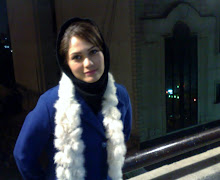A New Day Has Come!
A feeling that matches this newness!
But, frankly speaking, my search didn’t lead to any result yet.
 When I studied about the holy and elegant custom of No-Rooz_ meaning new day_ and found out that how far we are standing from its reality and nature, I felt like a blind follower! And realized that how ignorant and indifference we are towards our customs.
When I studied about the holy and elegant custom of No-Rooz_ meaning new day_ and found out that how far we are standing from its reality and nature, I felt like a blind follower! And realized that how ignorant and indifference we are towards our customs.Especially, because I had an experience of Iran’s wounded history in my last post about the movie 300, I really felt pity for our to be forgotten PARS. And I know that we should not let this treasure to be fallen into the valleys of forgetfulness.
I found some interesting information and details about our custom of No-Rooz, and the reasons behind them; So here I will share them with you:
As I said above, No-Rooz in Persian means "New[-year]-day". It is the beginning of the year not only for we Iranians, but also for the people of Afghanistan, Azerbaijan, and Tajikistan. Other Asian republics of the former Soviet Union are joining the group, and Turkey has decided to declare No-Rooz a holiday, too. It is also celebrated as the New Year by the people of the Iranian stock, particularly the Kurds, in the neighboring countries of Georgia, Iraq, Syria, and Turkey.
.jpg)
Every house gets a thorough cleaning almost a month before. In Sasanian Era, the ten last days of the year was celebrated. Since the ghosts and the spirit of nature come back to the earth, they lit fire and didn’t let it be out during the whole night. But from this custom, just Char-shanbe suri (the last Wednesday Eve of the year) is remained.Wheat, barley, lentils, and other vegetable seeds are soaked to grow on china plates some ten days in advance, so that the sprouts are three to four inches in height by No-Rooz.

In the table of Haft Sin (7 s), there is a mirror in front of the candles which doubles the light and shows the respect to the fire that is holy for Zarathushtra. The lit candles show the long lifetime of the family members and because of that, they must not be blown out, unless with some green leaves or candies. There are some eggs, mostly as many as the family members, which symbolizes the reproduction; some Changes (sekkeh), which symbolizes the wealth, a pair of golden fish which symbolizes the life and sustainability, and a kind of flower, (sonbol) which its aroma brings the news of coming spring.
.jpg)
The other elements of the table must be 7 objects which their name start with “s” or “sh” (due to the ancient beliefs). The number 7 is taken from the 7 "Amshaspandan" (angles) in Zarathushtra religion, which are Ourmozd, Vahman, Ordibehesht, Shahrivar, Sepandamaz, Khoordad and Amordad.
My No-Rooz Table
.jpg)
Second Plate: "Sumac," exotic in its own way, it makes your favorite kabobs have a tangy taste, a taste you relish; so it symbolizes taste.
Third Plate: "Sir," garlic. Some may not like its aroma and others love it. It lowers blood pressure and pacifies. It symbolizes peace and purity.
Fourth Plate: "Samanu," a sweetish paste, a kind of "halwa," made from germinating wheat. It symbolizes the sprouting spring, the time for happy growth.
Fifth Plate: "Sib," apple. It symbolizes the fruits of our world, both literally and allegorically.
Sixth Plate: "Senjed," the tasteless berry of the sorb tree. It is the fruit of a tree which provides shade in summer and symbolizes the shelter and security you need when you want a rest.
Seventh Plate: "Sabzi," fresh green herbs. It comes from green fields and symbolizes prosperity. Some people would place three plates of Sabzi in order to show “goftare nik” (nice words), “pendare nik” (nice thoughts), and ‘kerdare nik” (nice acts).
.jpg) Some people may place bread, nuts, fruits, and some rice on the table.
Some people may place bread, nuts, fruits, and some rice on the table.Family members all dressed in their best, sit around the table and eagerly await the announcement of the exact time of vernal equinox over radio or television. The head of the family recites the No-Rooz prayers, and after the time is announced, each member kisses the other and wishes a Happy No-Rooz. Elders give gifts to younger members. Next the rounds of visits to neighbors, relatives, and friends begin. Each visit is reciprocated.
Zarathushtra's Birthday and No-Rooz festival are celebrated by Zarathushtis at social centers on about 6 Farvardin (26 March).
.jpg)
Singing and dancing is, more or less for the first two weeks, a daily routine. The festivity continues for 12 days, and on the 13th morning, the mass picnic to countryside begins. It is called "Sizdeh-Bedar," meaning "thirteen-in-the-outdoors." A wrong belief among the recent generation is that the number 13 is sinister and that’s why we go outdoors. But this number is not sinister, but even holy and respectful in the Zarathushtra religion. In this day the people pray for raining and ask a better agricultural production. Cities and villages turn into ghost towns with almost all the inhabitants gone to enjoy the day in woods and mountains along stream and riversides. People sing, dance, and make merry. Girls of marriageable age tie wild grass tops into knots and make a wish that the following No-Rooz may find them married and carrying their bonny babies!
http://www.aftab-magazine.com/1/page3:1
http://www.tehroon20.com/mag/2007/03/post_340.html#more
http://www.iranchamber.com/history/







1 comment:
vay vay vay, ajab sofreye 7sine nazi. motmaennan khodet ino dorost kardi mitra. baba, kheili karet doroste.
rasti in ghazieye sofreye 7shin dige chi bud?! sharab dige kodume...?!!! :))
Post a Comment